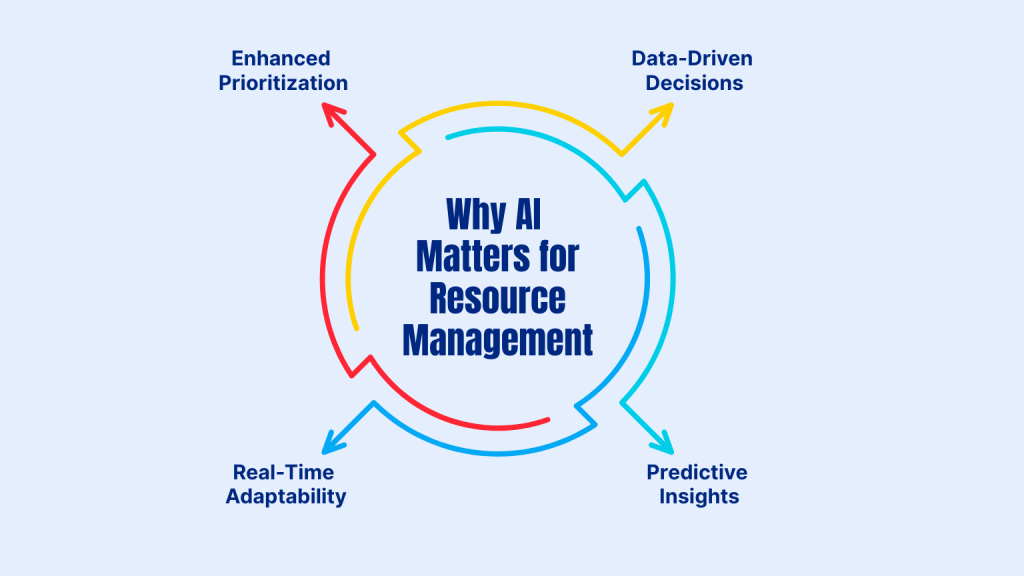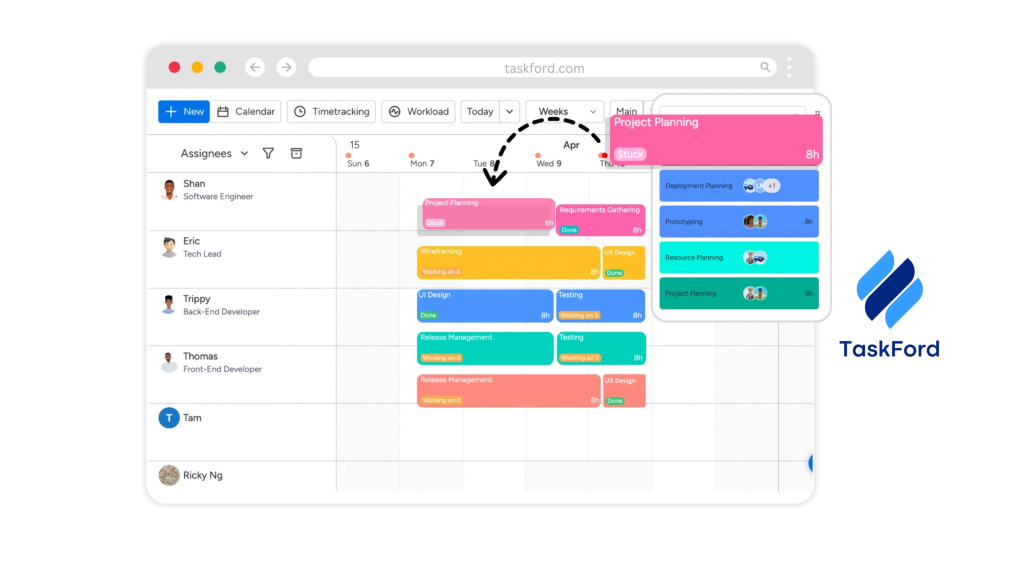Effective resource management is the cornerstone of successful project execution. Whether you’re leading a small team or managing a large-scale operation, allocating resources efficiently and prioritizing tasks can determine your project’s success. Artificial intelligence (AI) offers powerful tools to enhance resource allocation strategies and task prioritization. This blog explores how AI can transform resource management and offers practical insights to optimize project outcomes.
What Is AI Resource Allocation?
AI resource allocation uses advanced algorithms and machine learning to assign resources like time, budget, personnel, and equipment to tasks for maximum efficiency. Unlike manual resource allocation, relying on subjective decisions, AI processes vast datasets to make informed choices. It predicts project demands, identifies bottlenecks, and suggests optimal resource distribution, making it ideal for complex projects with multiple dependencies.
Why AI Matters for Resource Management

Resource allocation challenges, such as overallocated staff, underused equipment, or budget overruns, can derail projects. AI addresses these with key benefits:
- Data-Driven Decisions: AI processes historical and real-time data to recommend efficient resource distribution.
- Predictive Insights: Machine learning forecasts resource needs, reducing shortages or overages.
- Real-Time Adaptability: AI adjusts allocations dynamically to handle changes like delays.
- Enhanced Prioritization: AI ranks tasks by urgency and impact, ensuring critical activities get resources first.
Practical Applications of AI in Resource Allocation
AI’s versatility enhances resource management across industries, including marketing. Here’s how it’s applied:
Construction
AI optimizes labor, materials, and equipment by analyzing timelines, weather forecasts, and supply chain data. For example, AI might reallocate workers to indoor tasks during predicted rain, minimizing downtime.
Software Development
AI assigns tasks based on developer skills and code complexity, predicting delays to reallocate resources. This ensures critical features are delivered on time.
Healthcare
Hospitals use AI to predict patient admissions, allocating staff and beds efficiently to improve care and reduce costs.
Manufacturing
AI optimizes raw materials and machinery by analyzing production schedules and inventory levels, preventing overstocking or idle equipment.
Marketing
AI transforms marketing by optimizing resource allocation for campaigns, content creation, and audience targeting. Machine learning analyzes customer data by browsing behavior, purchase history, and social media engagement to allocate budgets and personnel to high-impact campaigns.
For example, AI can prioritize ad spend on channels with the highest ROI, like targeted social media ads, based on real-time performance data. It also automates content creation, such as generating email subject lines or social media posts, freeing marketers to focus on strategy. Predictive analytics forecast customer trends, enabling proactive budget allocation to campaigns likely to drive conversions.
Enhancing Task Prioritization with AI
Task prioritization is integral to effective resource allocation, ensuring resources are directed to the most critical activities. AI significantly enhances this process by leveraging data-driven insights and automation, offering a level of precision that manual methods struggle to match. Here’s how AI transforms task prioritization:
- Mapping Dependencies: AI identifies task interdependencies, ensuring resources are allocated to tasks that unblock others.
- Analyzing Impact: AI evaluates tasks based on their potential impact on project goals. In marketing, it might prioritize content creation over social media scheduling if data shows content drives higher engagement, ensuring resources focus on high-value outcomes.
- Assessing Risks: AI flags high-risk tasks that could cause delays or failures, such as a critical coding task prone to errors. By identifying these risks early, teams can allocate additional resources like extra developers or time to mitigate potential issues, keeping projects on track.
- Dynamic Reprioritization: AI adapts priorities in real time based on changing conditions. For instance, if a key team member is unavailable, AI can reassign tasks to available staff or adjust deadlines, ensuring continuity.
Implementing AI Resource Allocation
Integrating AI requires strategic planning. Here’s how to start:
- Identify Needs: Pinpoint challenges, like overallocated staff or inefficient campaign budgets, to select appropriate tools.
- Choose AI Tools: Project management tools with AI capabilities offer predictive analytics and resource tracking.
- Integrate Systems: Ensure AI tools connect with existing software for smooth data flow.
- Train Teams: Educate staff on using AI recommendations while valuing their expertise.
- Monitor Progress: Use AI reports to track resource utilization and refine strategies.
Meet TaskFord – The Next-Gen AI for Resource Allocation
What is TaskFord?
TaskFord is a comprehensive project management and resource planning platform designed to help teams of all sizes stay organized, aligned, and efficient. It offers a range of features that support both task and resource management, making it easier for teams to track progress, allocate resources, and manage schedules.

What Makes TaskFord Stand Out?
TaskFord offers a powerful platform for resource management and task prioritization. Being a comprehensive project management and resource planning platform designed for all teams, TaskFord provides the following key features:
- Flexible Views: Track tasks with ease using List, Table, Kanban, or Calendar views, allowing for tailored project oversight to suit your team’s needs.
- Task Assignment & Prioritization: Assign tasks seamlessly and prioritize them with an intuitive drag-and-drop interface, ensuring alignment with project goals.
- Real-Time Progress Tracking: Stay on top of project timelines by monitoring task progress with live status updates and visual indicators.
- Capacity & Workload Management: Get a clear view of team capacity and workloads, enabling you to balance assignments and prevent overburdening.
- Efficient Resource Allocation: Allocate both personnel and budgets effectively, ensuring that resources are aligned with task requirements.
- Leave Management: Plan and track employee leave to maintain team availability and prevent disruptions to project timelines.
TaskFord empowers teams with straightforward tools, ideal for small businesses or industries preferring manual processes. For example, in marketing, TaskFord’s campaign planning templates allow managers to manually allocate budgets and assign tasks, with dashboards to track performance and adjust priorities.
Challenges of AI Resource Allocation
Implementing AI for resource allocation brings powerful benefits but presents challenges that need careful management. Below are the key hurdles, outlined concisely:
- High Initial Costs: AI requires investment in software, training, and data systems. Tools can be costly for small teams, requiring a balance between upfront expenses and long-term savings.
- Data Quality Issues: AI relies on accurate data. Incomplete or outdated records, like missing project metrics, lead to unreliable outputs. Robust data management is essential for effective AI use.
- Team Disengagement: Overusing AI can make teams feel undervalued, lowering morale. For example, marketers might resist AI-driven campaign allocations if their expertise is overlooked. Encourage feedback to blend AI with human judgment.
- Learning Curve: AI tools require technical know-how, which can slow adoption. Teams new to platforms may need training to use them effectively.
The Future of AI in Resource Management
AI’s role in resource management is expanding. Future trends include:
- Advanced Machine Learning: Models will incorporate broader variables, like market trends, for precise predictions.
- Natural Language Processing: Marketers can query AI conversationally, like asking, “Which campaigns need more budget?”
- IoT Integration: Sensors will feed real-time data to AI, optimizing physical resource use in manufacturing or construction.
- Personalized Allocation: AI will match tasks to team members’ strengths, boosting productivity.
Measuring AI’s Impact
Evaluating AI’s effectiveness ensures alignment with project goals. Track these KPIs:
- Project Completion Time: Compare timelines pre- and post-AI to assess efficiency.
- Resource Utilization: Measure usage rates (e.g., hours worked vs. available) to ensure efficiency.
- Cost Savings: Check if AI reduces overruns, like optimizing ad spend in marketing.
- Task Completion Accuracy: Track on-schedule task completion to gauge prioritization success.
- Team Satisfaction: Use surveys to measure reduced stress from better allocation.
- Error Reduction: Monitor fewer errors, like misallocated budgets.
Conclusion
AI resource allocation revolutionizes project management across construction, software development, healthcare, manufacturing, and marketing by delivering data-driven insights, predictive analytics, and dynamic prioritization. For teams preferring manual control, TaskFord offers a simple, effective alternative with robust features for all teams. By assessing your needs, choosing the right tools, and training your team, you can enhance resource management and achieve project success.
Also Read: HVAC Jokes for Social Media Posts

